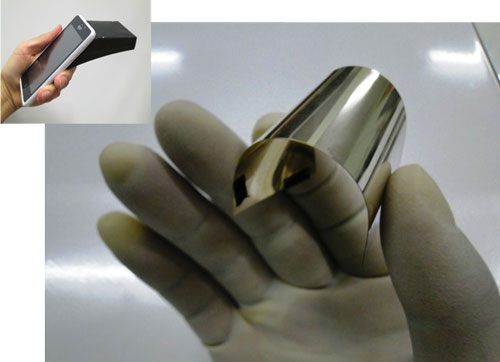| Posted: Sep 11, 2015 | |
Smartphone-based nano-biosensors for early detection of tuberculosis |
|
| (Nanowerk Spotlight) Tuberculosis (TB) is a widespread infectious disease caused by M. Tuberculosis, which most commonly affects the lungs but can also attack other body parts. It is estimated that one-third of the world's population is infected with M. tuberculosis at least once and new infections continue to occur in about 1% of the population each year. More than 80% of TB infections come from underdeveloped/developing communities that lack easy access to health care providers. | |
| A typical preliminary test for TB includes culturing the samples for at least 1-2 weeks in a lab, followed by examination under a fluorescence microscope. The lack of rapid, accurate, and inexpensive point-of-care tools for detecting low amounts of M. Tuberculosis is a critical bottleneck in early diagnosis and appropriate treatment. | |
| A team of researchers from Clemson University and Sri Sathya Sai Institute of Higher Learning has collaboratively developed a rapid and flexible nano-biosensor for diagnosing TB in early stages using smartphones. They reported their findings in the September 8, 2015 online edition of Physical Chemistry Chemical Physics ("Flexible Ag-C60 nano-biosensors based on surface plasmon coupled emission for clinical and forensic applications"). | |
 |
|
| Silver and fullerene coated cellulose-acetate sensors are flexible and could be used to detect tuberculosis in early stages. The inset shows a smartphone-based detection scheme for use in point-of-care settings. | |
| These inexpensive biosensors are fabricated by coating thin films of silver and fullerenes (spherical carbon cages, also known as buckyballs) onto a flexible cellulose acetate substrate. | |
| In these sensors, the isotropic fluorescence from dye-stained bacteria can be coupled to the silver-coated cellulose substrate using surface plasmons. The emission from the dye could be observed by taking a picture from a smartphone camera attached to a simple diffraction grating made from compact discs. | |
| The intensity of the emission recorded by the smartphone provides information on the density of bacteria and thus stage of the infection. | |
| These new findings show that surface plasmons, when coupled optimally through fullerenes, boost the efficiency to levels where even single bacterium could also be detected. | |
| "Fluorescence is always isotropic and only 1% of emissions from the dye can be captured using traditional lab-based detectors," notes Pradyumna Mulpur, a graduate student at the Sri Sathya Sai Institute of Higher Learning, who carried out the study. "We used the concept of surface-plasmons to collapse the otherwise into a directed emission to boost the efficiency. The ability to enhance the emission directly implies that we can detect bacteria even at low densities as in the early stages of the disease." | |
| Although surface plasmons have been known for at least two decades, a major challenge in coupling it to fluorescence from dyes has been the absence of efficient spacer layers. An optimal distance between the dye and silver films that exhibit surface plasmons is necessary to achieve high-signal enhancements. | |
| "We have been looking for the best spacer layer with a controllable thickness to enhance the coupling," Ramakrishna Podila, an Assistant Professor in the Department of Physics and Astronomy at Clemson University and principal investigator of this study, tells Nanowerk. "We realized that graphene and fullerenes are the best choice. In fact, they not only provide optimal spacing but also protect silver films from oxidation. This enhancement allows us to use a simple camera app on a smartphone to capture vital information about the progression of the disease." | |
| In addition to detecting TB, the team showed that these sensors could be used as forensic tools for sensing body fluids such as semen in crime scenes. | |
| Most of the on-field diagnostic tests, such as UV-illumination, for detecting semen are presumptive. However, the plasmon-based sensors developed in this study can selectively identify semen over other body fluids such as saliva and urine. | |
| These flexible sensors could also be used as swabs to collect samples in crime scenes. The team hopes that these sensors could be used for forensic purposes or point-of-care sensing in resource-limited settings to effectively diagnose and thereby prevent and cure new TB infections. | |
 By
Michael
Berger
– Michael is author of three books by the Royal Society of Chemistry:
Nano-Society: Pushing the Boundaries of Technology,
Nanotechnology: The Future is Tiny, and
Nanoengineering: The Skills and Tools Making Technology Invisible
Copyright ©
Nanowerk LLC
By
Michael
Berger
– Michael is author of three books by the Royal Society of Chemistry:
Nano-Society: Pushing the Boundaries of Technology,
Nanotechnology: The Future is Tiny, and
Nanoengineering: The Skills and Tools Making Technology Invisible
Copyright ©
Nanowerk LLC
|
|
|
Become a Spotlight guest author! Join our large and growing group of guest contributors. Have you just published a scientific paper or have other exciting developments to share with the nanotechnology community? Here is how to publish on nanowerk.com. |
|
